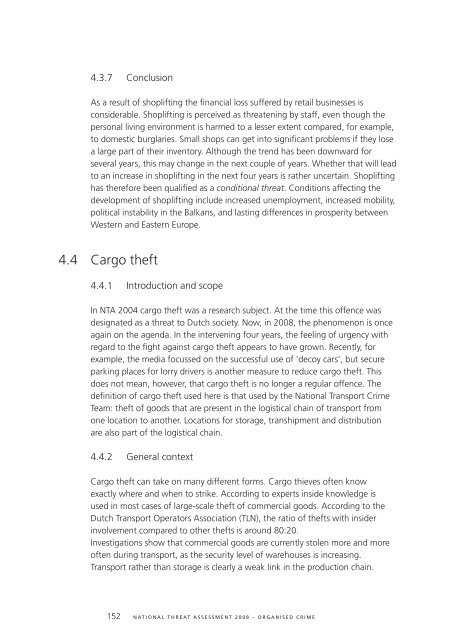National Threat Assessment 2008. Organised Crime - Politie
National Threat Assessment 2008. Organised Crime - Politie
National Threat Assessment 2008. Organised Crime - Politie
Create successful ePaper yourself
Turn your PDF publications into a flip-book with our unique Google optimized e-Paper software.
4.3.7 Conclusion<br />
As a result of shoplifting the financial loss suffered by retail businesses is<br />
considerable. Shoplifting is perceived as threatening by staff, even though the<br />
personal living environment is harmed to a lesser extent compared, for example,<br />
to domestic burglaries. Small shops can get into significant problems if they lose<br />
a large part of their inventory. Although the trend has been downward for<br />
several years, this may change in the next couple of years. Whether that will lead<br />
to an increase in shoplifting in the next four years is rather uncertain. Shoplifting<br />
has therefore been qualified as a conditional threat. Conditions affecting the<br />
development of shoplifting include increased unemployment, increased mobility,<br />
political instability in the Balkans, and lasting differences in prosperity between<br />
Western and Eastern Europe.<br />
4.4 Cargo theft<br />
4.4.1 Introduction and scope<br />
In NTA 2004 cargo theft was a research subject. At the time this offence was<br />
designated as a threat to Dutch society. Now, in 2008, the phenomenon is once<br />
again on the agenda. In the intervening four years, the feeling of urgency with<br />
regard to the fight against cargo theft appears to have grown. Recently, for<br />
example, the media focussed on the successful use of ‘decoy cars’, but secure<br />
parking places for lorry drivers is another measure to reduce cargo theft. This<br />
does not mean, however, that cargo theft is no longer a regular offence. The<br />
definition of cargo theft used here is that used by the <strong>National</strong> Transport <strong>Crime</strong><br />
Team: theft of goods that are present in the logistical chain of transport from<br />
one location to another. Locations for storage, transhipment and distribution<br />
are also part of the logistical chain.<br />
4.4.2 General context<br />
Cargo theft can take on many different forms. Cargo thieves often know<br />
exactly where and when to strike. According to experts inside knowledge is<br />
used in most cases of large-scale theft of commercial goods. According to the<br />
Dutch Transport Operators Association (TLN), the ratio of thefts with insider<br />
involvement compared to other thefts is around 80:20.<br />
Investigations show that commercial goods are currently stolen more and more<br />
often during transport, as the security level of warehouses is increasing.<br />
Transport rather than storage is clearly a weak link in the production chain.<br />
152 <strong>National</strong> <strong>Threat</strong> <strong>Assessment</strong> 2008 – <strong>Organised</strong> crime








